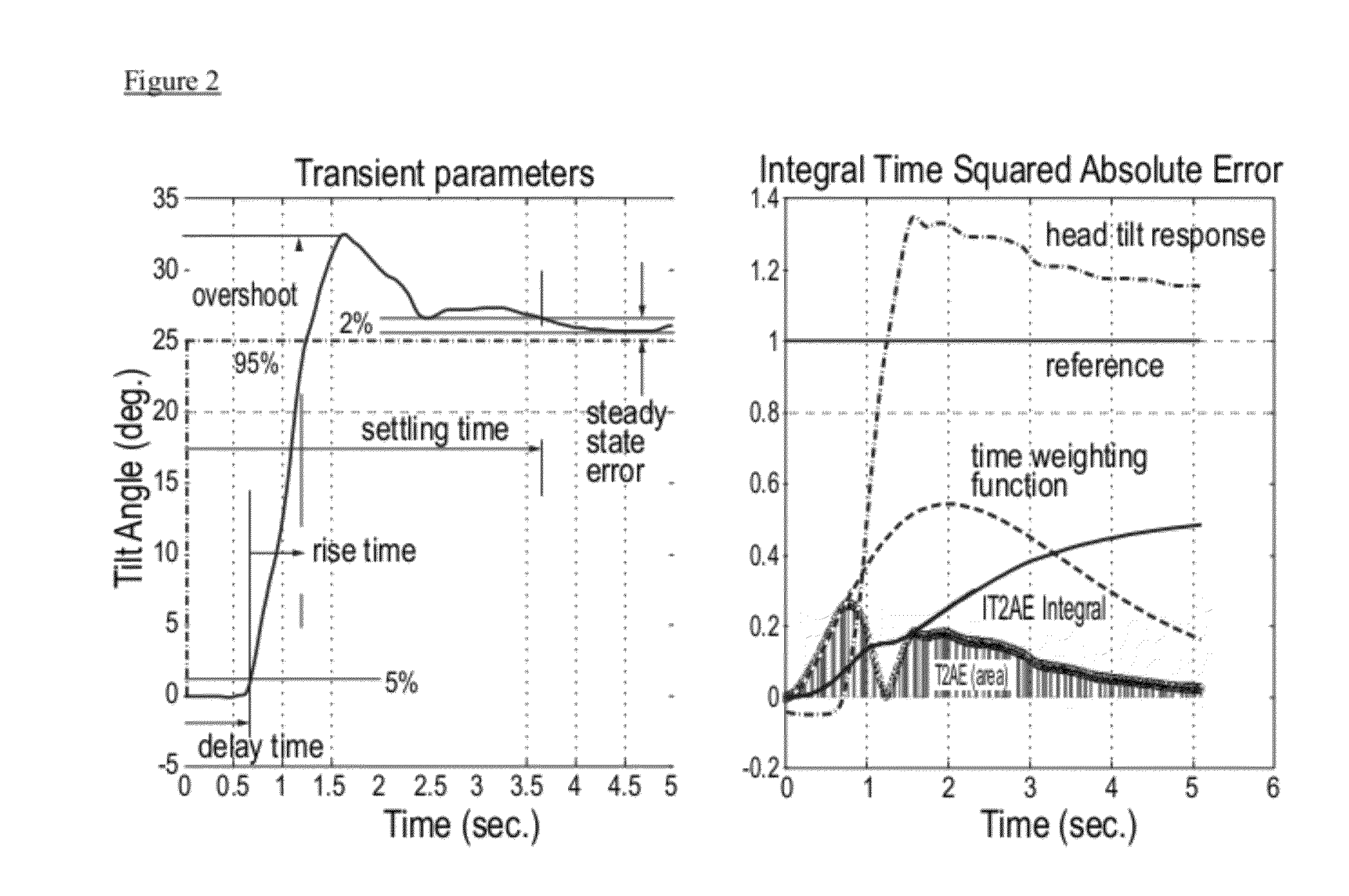Head tilt response
a technology of head tilt and response, applied in the field of measuring the perception can solve the problems of incongruous change in the angle of the gravitational vertical between successive images, and inability to accurately detect the gravitational vertical
- Summary
- Abstract
- Description
- Claims
- Application Information
AI Technical Summary
Benefits of technology
Problems solved by technology
Method used
Image
Examples
example 1
Subjects
[0073]Twenty eight normal subjects without any history of vestibular disorders were assessed (F: 19, M:9, mean age:30). Five patients (F: 5, mean age: 56.6) with vestibular disorders studied with bed side examination, electronystagmography (ENG), auditory testing and evaluation by CT scan images, as well as the HTR test. The patient population included 4 unilateral (UVL) and 1 bilateral vestibular loss (BVL). The five patients showed vestibular hypofunction performed by caloric testing and clinical features related to the UVL and BVL (Table 1).
TABLE 1Characteristics of patients with vestibular disordersPatientDisorderEarAgeGenderOnset1UVL (PerilymphaticR52F2weeksfistula)2UVL (VestibularR67F4weeksneuronitis)3UVL (VestibularL56F2weeksneuronitis)4BVL (Ototoxicity)—51F2years5UVL (PANS)*R57F6weeks*Post Acoustic Neurinoma Surgery
[0074]While not wishing to be bound by any particular theory, because the populations were below 70 years old, aging of end organs was probably not a sign...
example 2
Experimental Setup
Test Description
[0075]Each subject stood on a firm horizontal surface wearing virtual reality goggles (Z800 3Dvisor, eMagin) and a light isolator to ensure that no external visual references were available. Subjects were then solely exposed to the visual stimulus displayed on the goggles. A head tracking device (InertiaCube2+, Intersense) was attached to the goggles to keep record of the angle of the subject's head. Stimulation and recording was accomplished by means of custom made software. The stimulus displayed on the goggles was a white stripe presented over a black background.
[0076]Each subject was presented with the stimulus on virtual reality goggles (Head Mounted Display, HMD) and was asked to tilt his or her head to align the bar with their GV (FIG. 1). All subjects were instructed to align the bar as soon as a new image appeared on the goggles. When the exercise started, a stripe was presented with a certain inclination for a specific amount of time, and ...
example 3
Results
[0088]FIG. 3 shows a typical HTR response for a normal subject along the whole trial while Table 3 shows the mean value, standard deviation and confidence intervals obtained for the six parameters considered.
TABLE 3Parameter characteristics obtained for normal subjects.SSE (%)TDT (sec)TRS (sec)TST (sec)OSP (%)IT2AEMean Value:−0.3710.601631.199002.005245.5920.08867MeanConfidenceInterval (95%):Min:−3.9920.574581.044131.824353.8090.07881Max:3.2490.628681.353882.186137.3760.09853Standard9.3370.069760.399410.466514.6000.02543Deviation: (SD)SD ConfidenceInterval (95%)*:Min:7.3820.055150.315780.368833.6370.02010Max:12.7080.094950.543650.634986.2610.03461
[0089]Each parameter was calculated in 3 steps and 5 trials giving a sample of 15 values per parameter. From these values mean and standard deviation that characterize a subject for each parameter were calculated. For the 28 mean values, mean and confidence interval were found, and likewise for the 28 standard deviation values.
[0090]...
PUM
 Login to View More
Login to View More Abstract
Description
Claims
Application Information
 Login to View More
Login to View More - R&D
- Intellectual Property
- Life Sciences
- Materials
- Tech Scout
- Unparalleled Data Quality
- Higher Quality Content
- 60% Fewer Hallucinations
Browse by: Latest US Patents, China's latest patents, Technical Efficacy Thesaurus, Application Domain, Technology Topic, Popular Technical Reports.
© 2025 PatSnap. All rights reserved.Legal|Privacy policy|Modern Slavery Act Transparency Statement|Sitemap|About US| Contact US: help@patsnap.com



